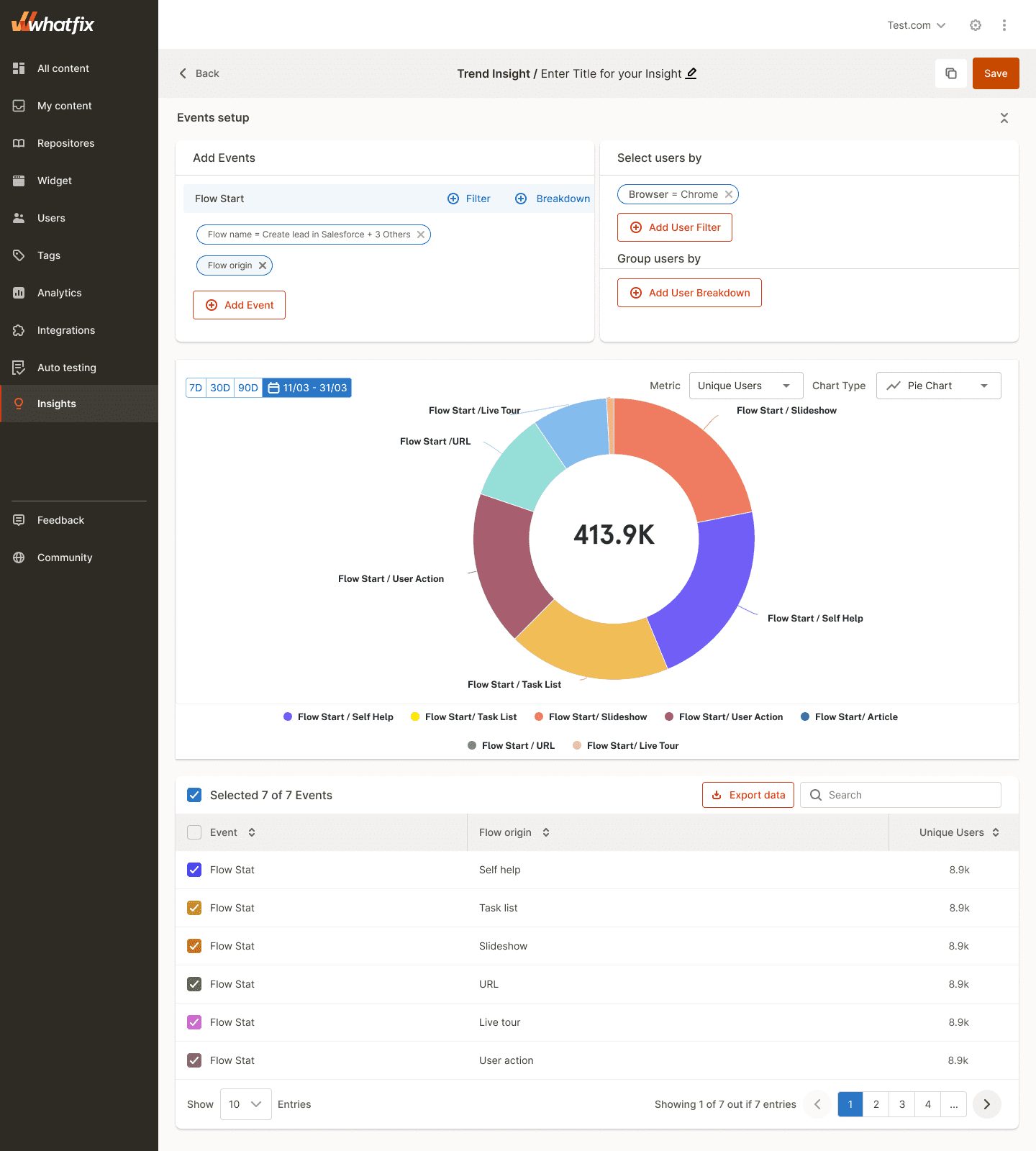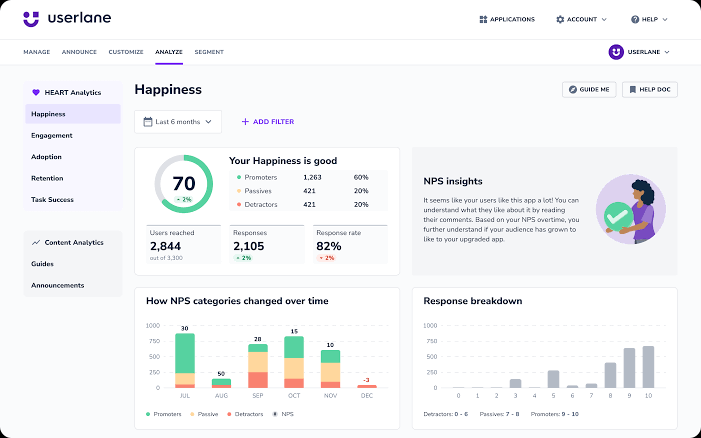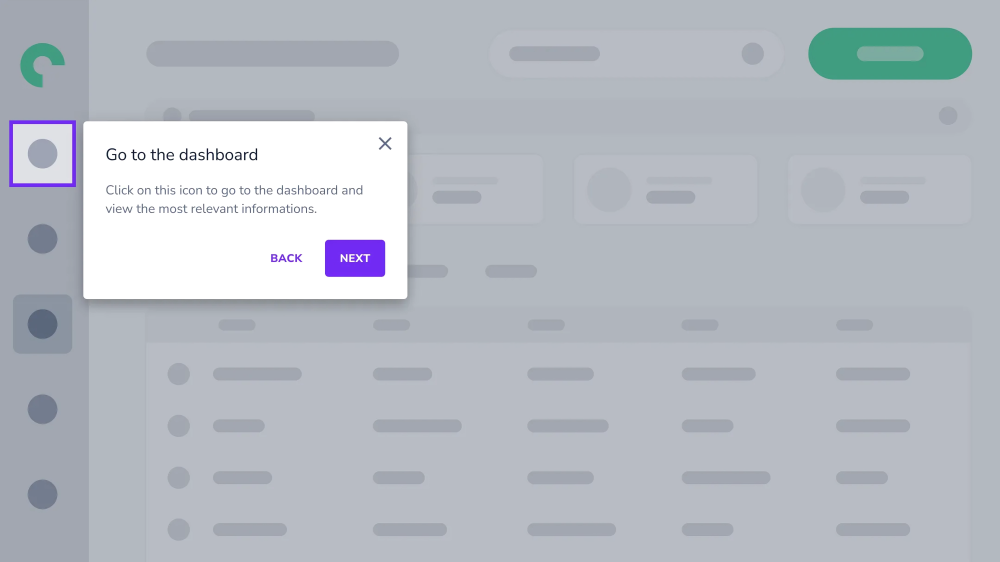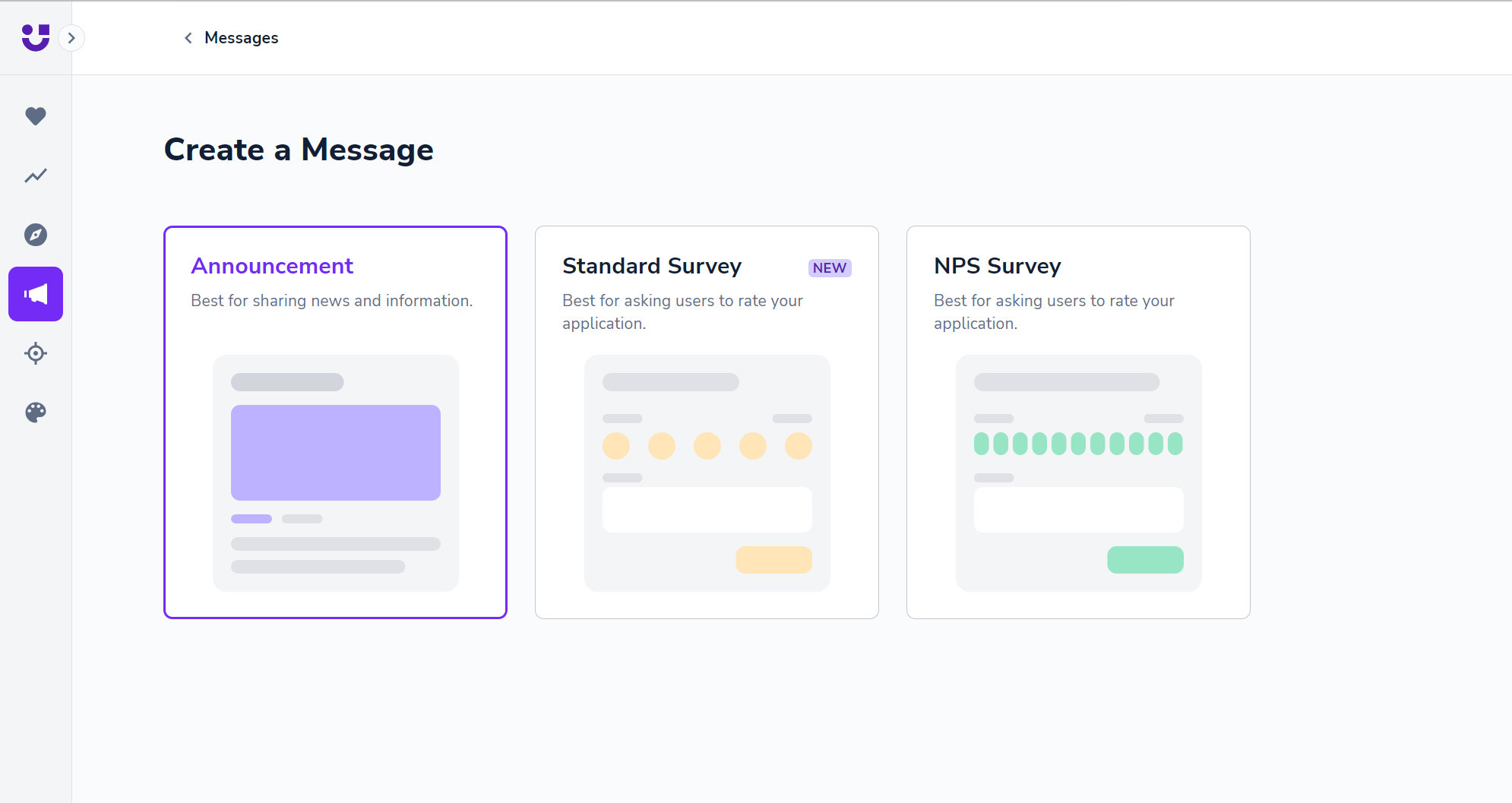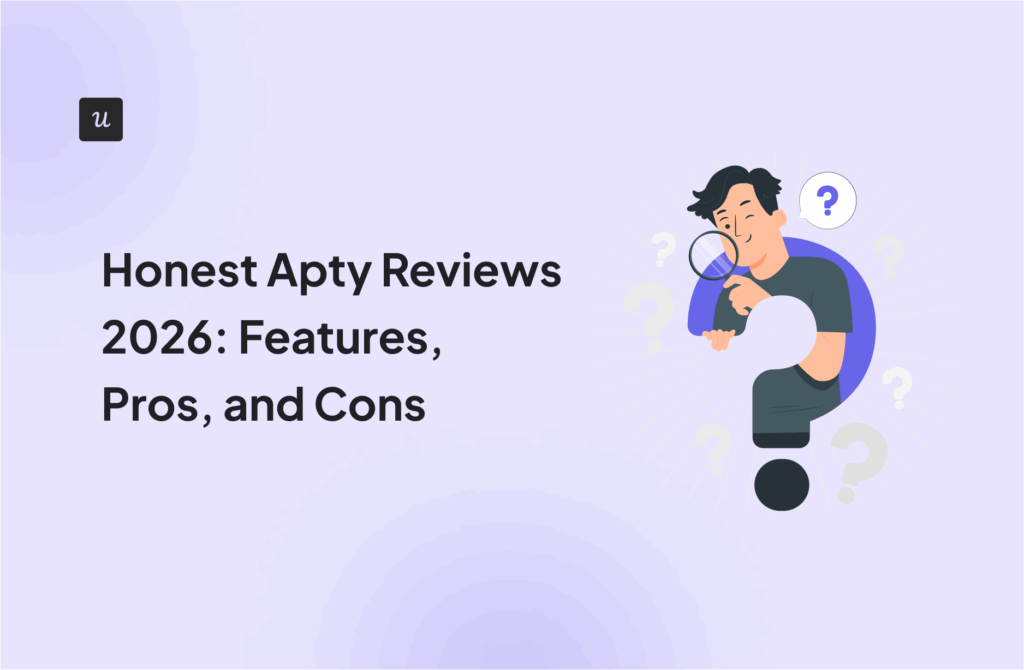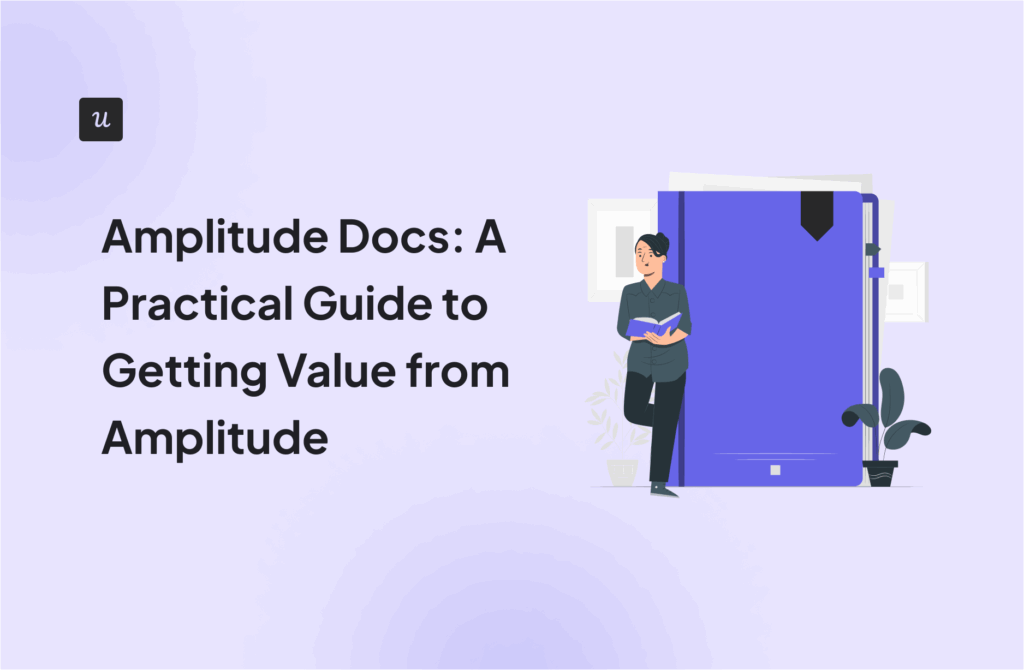
Try Userpilot Now
See Why 1,000+ Teams Choose Userpilot

Whatfix vs Userlane: Comparison summary
- Let’s explore how Whatfix, and Userlane compare when it comes to user onboarding and other common use cases.
-
- Whatfix is a digital adoption platform that helps enterprise organizations with onboarding, training, and supporting their employees or customers. It accomplishes this through in-app guidance and messaging to provide on-demand support whenever it’s needed.
- Userlane is a no-code digital adoption platform used to measure how employees use applications, identify areas for improvement, and offer real-time guidance directly within any application.
-
- If you’re looking for a better option for user onboarding, Userpilot exceeds both functionality and value for money compared to other tools on the list.
- Userpilot is a product growth platform that drives user activation, feature adoption, and expansion revenue. It also helps product teams collect user feedback, streamline onboarding, and gather actionable insights from analytics. Get a Userpilot demo for user onboarding and drive your product growth code-free.
What is Whatfix?
Whatfix is a digital adoption platform that helps enterprise organizations with onboarding, training, and supporting their employees or customers. It accomplishes this through in-app guidance and messaging to provide on-demand support whenever it’s needed.
The solution also lets you track analytics on all in-app guidance, collect user feedback, build out self-serve content, and automate certain flows. Whatfix even has integrations with Salesforce, Amplitude, Google Analytics, Slack, Confluence, and other platforms to maximize collaboration.
What is Userlane?
Userlane is a no-code digital adoption platform used to measure how employees use applications, identify areas for improvement, and offer real-time guidance directly within any application.
In addition, it allows you to get a real-time view of digital transformation progress in your organization. You can now delve deeper into user behaviors across different applications and analyze engagement levels so you can optimize user experiences.
Whatfix vs Userlane for user onboarding
In this section of the article, we’re really going to compare Whatfix vs Userlane in terms of user onboarding. That way, we’ll be able to figure out which tool – Whatfix or Userlane – is the best option depending on your use case.
Whatfix for user onboarding
User onboarding is a complex process that only the most flexible tools can pull off. Whatfix has its fair share of bugs and technical quirks but there are a few features that bolster its onboarding capabilities — namely its tours, checklists, and integrations.
Here’s an overview of Whatfix’s onboarding features:
- Whatfix lets you create interactive product tours for both users and employees. This reduces the time to value (TTV), whether it’s for customers using your product or employees learning how to use a solution in the internal tool stack.
- Onboarding checklists (known as task lists on Whatfix) give new users or employees a clear next step on their journey toward product adoption. Whatfix lets you create these checklists as widgets target specific segments, and group tasks under headers.
- Whatfix’s gallery of direct integrations with tools like Salesforce, Amplitude, SurveyMonkey, and more helps you centralize all onboarding data. The onboarding metrics gathered and synced across tools can then help you streamline your in-app flows.
Userlane for user onboarding
Teams use Userlane to ditch the stress of manual onboarding. The platform allows you to build a customized and interactive onboarding dashboard for each software, promoting an easy software onboarding experience every time.
Here are some ways Userlane helps with onboarding:
- Digital adoption solution: Userlane has a digital adoption solution that provides on-screen, step-by-step guidance to your users. This way, users can navigate your software with ease. You can also create an interactive in-app guide that walks users through tasks, so there’s no steep learning curve or need for external training materials.
- User-specific communication: User onboarding isn’t one-size-fits-all. Everyone’s needs are different. You can customize and improve their walkthroughs and communication based on the user’s behavior and software. Personalized communication makes it easy to remember how to use the features and get help.
- Comprehensive Analytics: Userlane has two applications for user analytics: HEART and Content analytics. HEART is Userlane’s premiere model to monitor software adoption across enterprise apps. The model shows if an application delivers the expected value. And highlights areas teams can improve and optimize. Content Analytics adds a layer of interactivity for guided learning within the platform. This feature allows teams to create guides, tips, and Pop-Ups and host NPS surveys.
Whatfix vs Userlane for product adoption
In this section of the article, we’re really going to compare Whatfix vs Userlane in terms of product adoption. That way, we’ll be able to figure out which tool – Whatfix or Userlane – is the best option depending on your use case.
Whatfix for product adoption
Product adoption is one of the most crucial stages of the customer lifecycle because it will determine whether they start to use the software regularly or churn in the next few weeks/months. Because Whatfix is a digital adoption platform, it has a few features designed to help with this:
- You create product tours for customers and employees to help them adopt software applications — without needing to write any code. These flows can be built on top of either your product or other applications in the company tool stack.
- With task lists (which are just onboarding checklists), you can guide new users through the most important features of a product and streamline the adoption journey. These widgets can also be set up to target different segments with personalized guidance.
- Embed contextual help within various areas of a product to ensure that adoption instructions are always visible wherever they’re needed most. You’ll then be able to check user data to see if the in-app guidance has the desired impact.
Userlane for product adoption
Teams use Userlane to ditch the stress of manual onboarding. The platform allows you to build a customized and interactive onboarding dashboard for each software, promoting an easy software onboarding experience every time.
Here are some ways Userlane helps with onboarding:
- Digital adoption solution: Userlane has a digital adoption solution that provides on-screen, step-by-step guidance to your users. This way, users can navigate your software with ease. You can also create an interactive in-app guide that walks users through tasks, so there’s no steep learning curve or need for external training materials.
- User-specific communication: User onboarding isn’t one-size-fits-all. Everyone’s needs are different. You can customize and improve their walkthroughs and communication based on the user’s behavior and software. Personalized communication makes it easy to remember how to use the features and get help.
- Comprehensive Analytics: Userlane has two applications for user analytics: HEART and Content analytics. HEART is Userlane’s premiere model to monitor software adoption across enterprise apps. The model shows if an application delivers the expected value. And highlights areas teams can improve and optimize. Content Analytics adds a layer of interactivity for guided learning within the platform. This feature allows teams to create guides, tips, and Pop-Ups and host NPS surveys.
Whatfix vs Userlane for customer experience
In this section of the article, we’re really going to compare Whatfix vs Userlane in terms of customer experience. That way, we’ll be able to figure out which tool – Whatfix or Userlane – is the best option depending on your use case.
Whatfix for customer experience
Customer experience insights are imperative for understanding how people use your product. Whatfix can be used to improve the product experience both for customers as well as your employees using internal software.
Here are the Whatfix features you can use to improve the customer experience:
- You can collect feedback from your customers or employees while they’re actively using a software application. These input fields can be used to collect feedback on the customer experience or specific aspects of the product.
- Ask scalar, multiple choice, and open-ended questions to get an accurate view of net promoter scores (as well as the driving forces behind each rating). Note that you’ll only be able to edit, delete, or reorder questions if you upgrade to Premium.
- Adding tooltips, hotspots, and beacons on top of a piece of software using Whatfix can draw attention toward specific features. Whatfix tooltips are particularly helpful because they expand when hovered over and provide additional information to users.
Userlane for customer experience
Userlane is not designed as a customer experience platform. However, it helps create different user segments for each customer depending on their preferences and specific needs.
Using a specialized tool is always going to cost less money and time. That’s why we recommend Userpilot for customer experience—since it’s probably the most cost-efficient product management tool to apply all these tactics (and you don’t need to code).
Whatfix vs Userlane for user feedback
In this section of the article, we’re really going to compare Whatfix vs Userlane in terms of user feedback. That way, we’ll be able to figure out which tool – Whatfix or Userlane – is the best option depending on your use case.
Whatfix for user feedback
Product feedback can help you identify friction points, squash bugs, and improve the overall experience for customers or employees using a piece of software. Whatfix lets you collect different types of feedback from users across multiple platforms:
- Whatfix has feedback forms that let users submit their feedback at any point in the product journey. This makes it easy to ask about specific features while a customer or employee is actively using it — leading to higher response rates and more accurate feedback.
- Whatfix’s surveys aren’t limited to PC users, as you’ll also be able to collect feedback from customers and employees who are on mobile devices. Whatfix lets you adjust the design and placement of your mobile surveys (either full screen, centered, or bottom).
- Lastly, Whatfix also lets you build NPS surveys that help with customer satisfaction benchmarking. Sadly, these surveys are quite limited on the Standard plan and you’ll have to upgrade to Premium if you hope to edit, delete, or reorder questions.
Userlane for user feedback
Userlane helps you create interactive tours and guides within your software.
These guides collect feedback from users as they navigate through the application.
This feedback can be through surveys, questionnaires, or specific prompts. The aim is to collect user product feedback, including opinions, suggestions, or concerns about the product. How? Through the following:
- Creates interactive tours to guide users through software.
- Collects feedback via surveys, questionnaires, and prompts.
- Gathers user opinions, suggestions, and concerns about the product.
Whatfix vs Userlane: Which one you should choose?
To further simplify this selection process, let’s break down the strengths and limitations of each tool. Understanding the distinct advantages and potential drawbacks of Whatfix and Userlane will provide you with a detailed roadmap for making a well-informed decision!
Pros and cons of Whatfix
Pros of Whatfix
Whatfix may not be as popular or widely adopted as competitors like WalkMe but it does have its fair share of benefits:
- Pricing: While Whatfix does not publish the exact cost of its plans publicly, numerous reports from customers suggest an average entry point of $1,000/month. This is significantly cheaper than its closest competitor, WalkMe, which reportedly starts at closer to $10,000/month.
- Automation: Whatfix Flows helps you automate repetitive tasks to save time. The Whatfix Flows dashboard also lets you analyze your existing flows and then use them to create entirely new automation in a single click.
- Integrations: Whatfix’s third-party integration options make it easy to incorporate the solution into the rest of your tech stack. It integrates with Salesforce, Amplitude, Google Analytics, Slack, and more — providing a good selection of the top CRM, analytics, and communication tools.
Cons of Whatfix
Whatfix offers a more affordable employee onboarding solution than its closest competitors but is limited by its lackluster analytics and support — along with its high-friction trial signup process for prospective customers.
Here are the key drawbacks of using Whatfix:
- Whatfix is quite lacking in the analytics department — both in comparison to direct competitors like WalkMe as well as other onboarding solutions like Userpilot, Appcues, or Pendo. If detailed user data matters to you, you’ll want to consider alternatives.
- Technical assistance (or the lack thereof) is arguably one of Whatfix’s largest weaknesses. While all plans promise to give you a customer success manager, most Whatfix users complain about the subpar support they provide.
- While Whatfix has a trial request page on its website, this form is buggy and inconsistent. You can reach out to support to request a trial directly but resolution times can be upwards of a month — and, in the end, you may even be redirected to a demo call instead of a trial account.
Pros and cons of Userlane
Pros of Userlane
Higher productivity, less support effort, and happier users are what Userlane is created for. From a vast spectrum of capabilities to elegantly crafted UI elements that cater to any walkthrough, regardless of its level of customization, Userlane stands out as a robust platform to bolster user engagement and product familiarization.
Let’s dive into the pros of using Userlane:
- Streamlined no-code interface: Userlane boasts a user-friendly dashboard, enabling even those with no coding background to easily design and implement onboarding flows.
- Product adoption analytics: Get a real-time view of digital transformation progress in your organization. Delve deeper into user behaviors across different applications and analyze engagement levels so you can optimize user experiences.
- Dynamic user walkthroughs: Craft compelling and interactive walkthroughs that intuitively guide users through your software, ensuring they grasp every essential feature.
- Versatile in-app communication tools: Whether tooltips, banners, or pop-up modals, Userlane offers many tools to engage users directly within your platform. With Userlane’s customer onboarding solution, you can tailor communications for different user segments, guiding them through the tasks and processes they will most likely need help with.
- Seamless third-party integrations: Integrate Userlane with various analytics tools, CRM platforms, and other essential software to ensure a harmonious workflow and data sharing.
- Granular audience segmentation: Understand your users and their needs better by segmenting them based on behavior, user type, or other customizable metrics. This ensures that your messaging and tours are always relevant and timely.
- Optimized A/B testing capabilities: Refine your onboarding and in-app messaging by A/B testing different approaches, enabling you to continually enhance user experience based on concrete data.
- Thoughtful pacing with walkthrough rate limiting: Ensure users aren’t too quickly bombarded with too much information. With Userlane’s rate limiting, you can pace the introduction of new features or tasks, striking a balance between informing and overwhelming.
Cons of Userlane
As with any tool, weighing its strengths and weaknesses is essential. Here are the notable drawbacks of adopting Userlane:
- Visual Customization Restrictions: One of Userlane’s apparent setbacks lies in its restricted visual customization capabilities. If you have an eye for aesthetic and unique branding elements might find the platform limiting. The lack of diverse templates and somewhat rigid design elements could impede brands from truly reflecting their identity.
- Analytical Ambiguities: In the age of data-driven decision-making, Userlane’s analytical powers — or the lack thereof — stand out. While it offers basic insights, those looking for a deep dive into granular user behavior, funnel analysis, heatmaps, and more might need to bridge the gap with external integrations.
- Integration Quandaries: Speaking of integrations, Userlane might not be the Swiss Army knife of connectivity that some businesses might be hoping for. While essentials like Zendesk, Google Analytics, Hubspot, and Salesforce are on the list, those yearning for a wider array of integration options might need to strategize around these limitations.
- Cost Considerations: Userlane’s pricing structure could be a roadblock, especially for startups and SMEs keen on budget constraints. The initial investment for Userlane might seem daunting, especially considering the added costs of potential integrations and the learning curve associated with maximizing the platform’s potential.
Userpilot – A better alternative for your SaaS
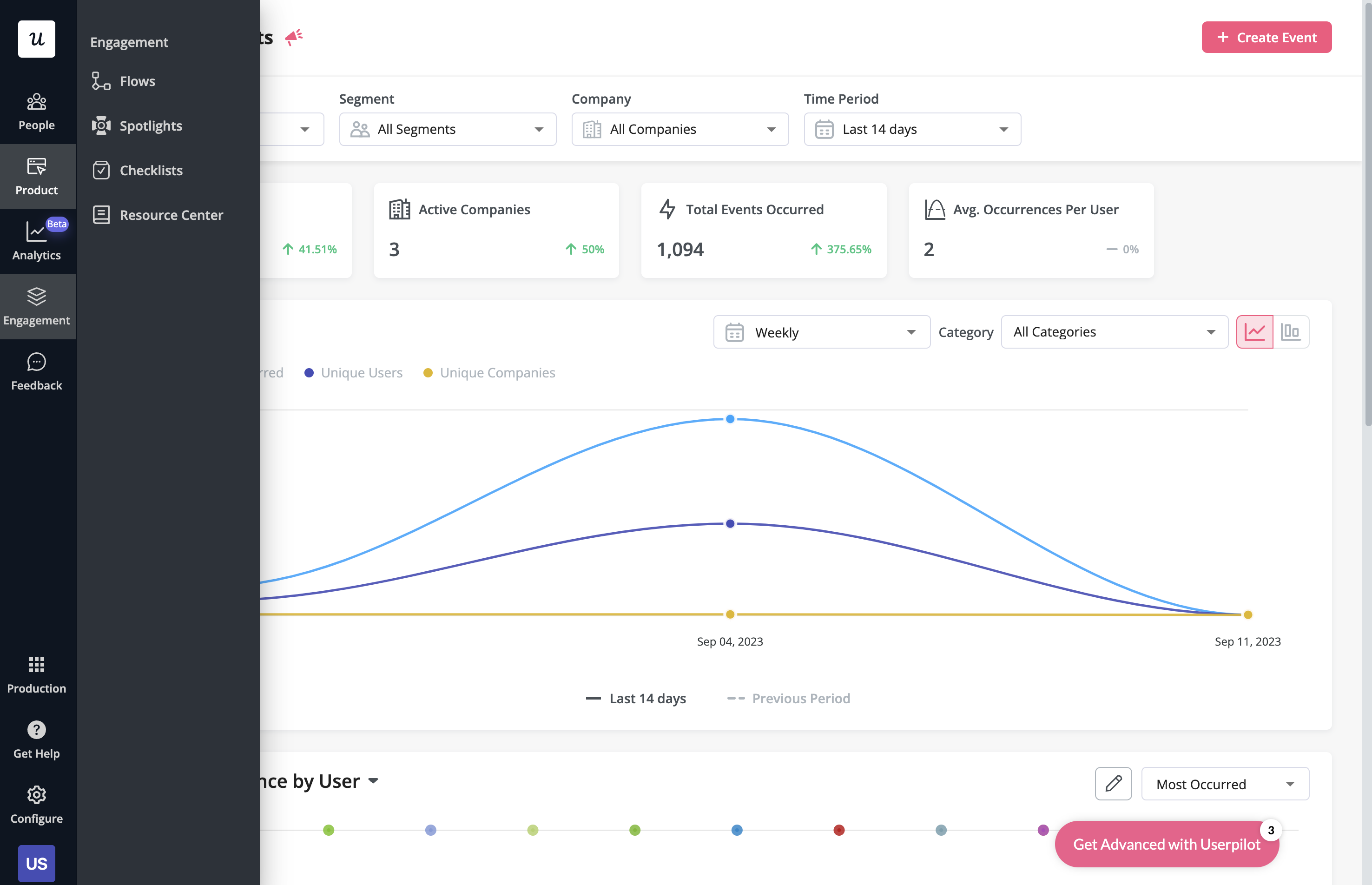
With Userpilot, you’ll be able to track both product usage and user behavior to get a holistic view of how customers use your product — which will guide future development, improve the user experience, and inform your growth efforts.
Pros of Userpilot
As a full-suite digital adoption platform, Userpilot has all the features you need to onboard users, track analytics, and gather feedback from customers without writing a single line of code. Here are a few pros of using Userpilot as your product growth solution:
- No-code builder: Userpilot’s Chrome extension lets you build flows, add UI elements, and tag features without writing a single line of code.
- UI patterns: There are plenty of UI patterns to choose from when using Userpilot, such as hotspots, tooltips, banners, slideouts, modals, and more!
- Startup-friendly: Userpilot’s entry-level plan gives you access to all available UI patterns so you can hit the ground running.
- Walkthroughs and flows: Build engaging interactive walkthroughs and personalized onboarding flows that target specific segments of your user base.
- Self-service support: Build an in-app resource center to help users solve problems, customize its appearance to align it with your brand, and insert various types of content (videos, flows, or chatbots) to keep your customers satisfied.
- A/B testing: Userpilot’s built-in A/B testing capabilities will help you split-test flows, iterate on the best-performing variants, and continually optimize based on user behavior.
- Feedback collection: Userpilot has built-in NPS surveys with its own unified analytics dashboard and response tagging to help you retarget users. There are other survey types to choose from and you can even create your own custom survey.
- Survey templates: There are 14 survey templates to choose from so you can gather feedback on specific features or run customer satisfaction benchmarking surveys like CSAT and CES.
- Advanced analytics: Userpilot lets you analyze product usage data, monitor engagement on all in-app flows, and use the data to create user segments that are based on behaviors instead of demographics.
- Event tracking: Userpilot’s no-code event tracking lets you tag UI interactions (hovers, clicks, or form fills) and group them into a custom event that reflects feature usage.
- Third-party integrations: Userpilot has built-in integrations with tools like Amplitude, Mixpanel, Kissmetrics, Segment, Heap, HubSpot, Intercom, Google Analytics, and Google Tag Manager so you can share data between all the solutions in your tech stack.
Cons of Userpilot
Of course, no tool is perfect and there are a few cons to consider before choosing Userpilot as your user onboarding or product growth solution:
- Employee onboarding: Currently, Userpilot only supports in-app customer onboarding.
- Mobile apps: Userpilot doesn’t have any mobile compatibility which could make it difficult for developers with cross-platform applications to create a consistent user experience for both versions of their product.
- Freemium plan: There’s no freemium Userpilot plan so those bootstrapping their startup and need sub-$100 solutions should consider more affordable onboarding platforms like UserGuiding or Product Fruits.
Conclusion
Hopefully, this post helped you decide whether Whatfix or Userlane is more appropriate for your company. As you can see – both have many upsides and downsides.
Undeniably, Userpilot provides a better value for money and is a better choice for a mid-market SaaS, especially when it comes to user onboarding and user feedback.
If you’re interested in finding more, book a demo with our team here!
Try Userpilot – the Best User Onboarding Solution for SaaS


